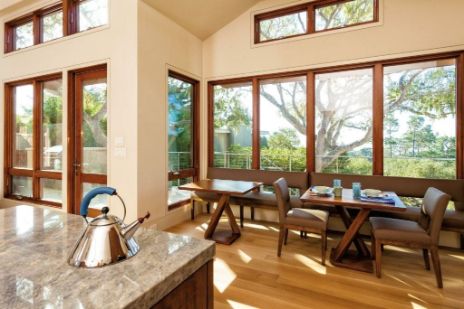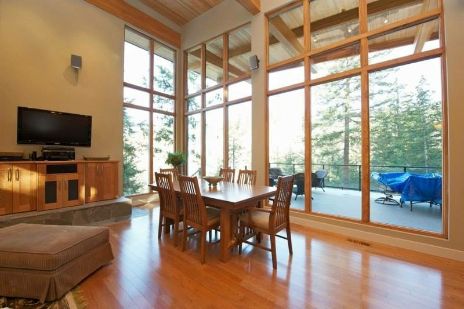
WINDOWS AND DOORS 101
There are a wide variety of windows and doors you can choose from. Learn more about each style to determine the best solution for your home, based on opening options, amount of light, ease of use and more.
Awning
Awning windows swing outward, with one sash hinged at the top. These windows are often placed above or below other windows and doors for additional ventilation. They open and close with the turn of one easy-to-reach handle, which is located on the bottom of the window frame.
Casement
Awning windows swing outward, with one sash hinged at the top. These windows are often placed above or bCasement windows feature one sash that is hinged on one side and swings outward. They open and close with the turn of one easy-to-reach handle, which is located on the bottom of the window frame.elow other windows and doors for additional ventilation. They open and close with the turn of one easy-to-reach handle, which is located on the bottom of the window frame.

Double Hung
Double Hung windows have two operating sash: one on the top that slides down and one on the bottom that slides up. These windows offer great ventilation. They also have an EZ Tilt option which allows both sashes to tilt in from the top for easy cleaning.
Single Hung
Single hung windows have one operating sash on the bottom that moves up and down. The top sash does not operate.
Glide-By/Slider
Glide-by/slider windows have one operating sash which moves side to side. The second sash does not operate.
Fixed/Direct Set Unit
Fixed/direct set units do not operate. These windows are available in a wide range of sizes and shapes, including rectangles, radius, trapezoids, octagons, etc.

Sliding Patio Door
Sliding patio doors slide on rollers and are perfect for tight spaces. These doors come in either a French style with a wider bottom rail or a narrow style with much more visible glass.
Swinging Patio Door
Swinging Patio Doors have hinges so the operating panels can swing inward or outward. You can choose from 1 or 2 operating panels, and up to 4 panels in one frame.
Bi-fold Patio Door
Bi-fold doors fold in like an accordion to create wide-open entryways. A multi-point locking system provides uncompromised security, while the revolutionary hinge system provides stability and smooth operation
Multi-slide Patio Door
Multi-slide patio doors allow you to slide multiple panels on a rail, providing the opportunity for wider openings and cleaner entryways. These doors are available in stacking or pocket configurations up to 20 feet wide.
FAQS
How often should residential windows be replaced?
Homeowners with windows over 25 years old should consider replacing them, both to gain the best energy efficiencies and to protect the “envelope” of the house. A home is an ideal candidate for a window replacement if its windows are sealed or painted shut, experiences ice buildup or a frosty glaze during the winter, gets fogged with condensation or has drafts that come through the windows.
What is uPVC?
“uPVC” is short for unplasticized polyvinyl chloride, a type of vinyl. Vinyl itself is made from petroleum and salt, and it’s recyclable.
What are your lead times?
At Statements Windows and Doors, an average lead time to from the day an order is placed to installation is approximately 4-6 weeks.
How do I remove the labels from a window?
Never use a razor blade or other metallic object to clean or remove residue from your window or door products. These can scratch the glass, leading to obstruction of clarity and/or glass breakage.
For general cleaning of the glass surface, we recommend a vinegar-based solution (10% vinegar and 90% water) or commercially available ammonia-free and alcohol-free window cleaners. Clean the glass surface with a lint-free cloth or paper towel to clean. Wipe dry with a clean, dry, lint-free cloth or paper towel. Avoid getting cleaning agents on any non-glass components. Occasional spot cleaning may be required to remove stubborn dirt or foreign material that has adhered to the glass surface. Apply a small amount of non-abrasive cleaner (such as Bar Keeper’s Friend) or organic solvent (such as Goof Off) to a clean, dry, lint-free cloth or paper towel. DO NOT APPLY CLEANER DIRECTLY TO THE GLASS. On the area affected, work the cloth in multiple directs until spot is removed. Avoid getting cleaning agents on any non-glass components. Follow the general cleaning instructions to remove any cleaner residue.
How long have you been in business?
Statements Windows & Doors was established in 2006. With over 35 combined years of experience combined with its knowledgeable sales staff, Statements can fulfill all of your window and door needs.
What geographic area do you service?
Statements Windows & Doors distributes, installs and services products within the Greater Toronto Area, South Eastern Ontario and Cottage Country.
What are your product warranties?
Product warranties vary between manufacturers, however most standard products come with a 20 year warranty. For warranty information about a particular manufacturer’s product, see the manufacturer’s catalog.
What do U-values and R-values really mean?
When choosing any window or door, look for information that lists the product’s U-Value and R-Value. U-Values represent the amount of heat that escapes through a wall, window, roof or other surface. The lower the U-Value, the more energy efficient a material is. R-Values are the direct opposite and they measure an object’s resistance to heat flow. The higher a material’s R-Value, the lower its U-Value, and the less energy it will lose. An R-Value depends on the number of layers of glass in a window, what type of gas is between those layers, and whether one or more of the layers of glazing have been treated with a Low E coating
What causes condensation on windows?
One of the results of creating tighter, more energy efficient homes, is an increase in elevated indoor humidity. Older homes had random gaps, which would allow for the release of warm, moist air and the replacement of cool drier air. Newer construction methods do not allow this natural air-to-air exchange, thus trapping any internally created humidity within the structure. Elevated amounts of humidity can cause condensation to form on cold surfaces. Sweaty, frosted or icy windows are all forms of condensation problems. Most people assume these situations indicate a problem with the window, but in fact, these are symptoms of excess humidity in the home. Condensation on your windows could be an indicator that other moisture problems could develop.
What does the term Low E stand for?
The term “Low E” means low emissivity. Emissivity is a property that’s unique to materials, such as glass, which light can freely pass through. Low E is a coating of non-visible, microscopic layers of silver sandwiched between layers of anti-reflective metal oxide coatings. Added to the surface of window and door glass, Low E provides greater energy efficiency, increased comfort and protection from damaging UV rays. By filtering out the part of the light spectrum that transmits heat, Low E reduces a window’s U-Value and increases its R-Value.
GLOSSARY
- Aluminum – A lightweight and strong material that is a cost effective alternative to wood. This material is corrosion-resistant and performs well in most climates.
- Vinyl – A strong plastic material that is used for its durability, energy efficiency and ability to stand up to the elements. This material will never fade in color, flake, peel or rot.
- Wood – Wood comes from trees that grow in a variety of species, such as fir, pine, mahogany or alder. Each species has a range of characteristics, like grain, color and sap content, which contributes to its unique appearance.
- Clad-Wood – Like a coat of armor, cladding is a strong layer of metal on wood, providing extra protection and low maintenance
Air Leakage Resistance
a characteristic of a closed window which restricts air passage when the window is subjected to a differential pressure.
Awning Window
a frame with a sash that swings outward at the bottom.
Operable Window
window that opens.
Meeting Stiles
the stiles of a pair of sash that meet when the sash are installed and in a closed position.
Mullion
a vertical or horizontal frame member that separates two or more sash, two or more fixed lights, or a combination of sash and fixed lights.
Muntin
a vertical or horizontal sash member that separates two or more lights within a sash.
Casement Window
a frame with a sash that may be fixed or hinged at the side to open in or out.
Certification
the process through which an independent body ensures that standards have been met by means of conducting audits and testing.
Combination Window
a combination of two or more complete window assemblies of the same or different types, whose frames are mulled together.
Complete Tear Out
an installation procedure in which the entire window assembly is removed right back to the rough opening and replaced with a completely new window.
Compression Seals
seals that can be squeezed tightly together between the moving sash and frame.
Condensation
the formation of moisture on the surface of the window.
Conduction
heat loss in windows that occurs primarily through the edges of the glazing and through the sash and frames.
Conductivity
the ability of a material to conduct heat from the warm side to the cold side.
Convection
heat loss that occurs due to air movement between the glazings of a window.
CSA-A440
minimum standards established by the Canadian Standards Association for air tightness, water tightness, wind resistance, condensation resistance, forced entry resistance and ease of operation. It also sets minimum requirements for all components and their materials from hardware, insect screens and weatherstripping to finishes and adhesives.
Dew point
the temperature at which the air can hold no more humidity and it condenses to liquid.
Double Hung
both sash, top and bottom in a vertical slider, open and close.
Double-Glazed Window
a window containing two layers of glazing with a uniform space in between the layers, usually two panes of glass.
Emissivity
relating to windows, the ability of the glazing to allow radiation to pass through it.
Energy Rating, or ER
a scale rating the comparative performance of windows based on three factors: 1) solar heat gains; 2) heat loss through frames, spacer and glass; and 3) air leakage heat losses.
Blow-Out
an assessment of failure or permanent deformation of any part of a window that would cause operational malfunction(s) and/or endanger the user when subjected to test pressures.
Brush type seal
most commonly found on sliders to facilitate the sliding movement. It consists of a brush that fits into a plastic track mounted on the sash or frame.
Permanent Deformation
a change in shape or dimension which does not disappear when pressures are no longer applied.
Projecting Window
a frame containing one or more sash, each of which swings horizontally to open in or out (Awning Window).
Sash
a unit assembly of stiles and rails for holding glass with or without dividing bars and muntins.
SAWDAC
Siding and Window Dealers Association of Canada
Shims
wedges, usually about 2″ wide used to position the window into the opening and ensure it is level, square and plumb.
Sill
the main cross or horizontal member forming the bottom of the frame.
Single Hung
only one sash, the bottom sash in a vertical slider, opens and closes.
R-Value
a measure of the resistance to heat flow through an object or material.
Radiation
heat loss that occurs through the window glass
Relative Humidity
the amount of water vapour in the air as a percentage of the maximum amount the air could hold at the same temperature.
Retrofit
an installation procedure that involves working within the existing frame and replacing the sash and the glazed unit with a new window.
Single-Glazed Window
a window containing just one layer of glazing, usually a single pane of glass.
Thermal Break
an insulating material applied to a high conducting material to slow the transfer of heat.
Triple-Glazed Window
a window containing three layers of glazing with two uniform spaces in between the layers.
Turn and Tilt Window
a frame with a sash that can either tilt inward like a hopper window, or to swing inward like a casement window.
Fixed Window
a frame including a fixed light or lights. They do not open.
Frame
the associated head, jamb, sill and, where applicable, mullion and muntin that, when assembled, house the sash or fixed glazing.
Solar Gain
the positive contribution to the heating of a building’s interior made by the sun’s energy passing through a window.
Spacer
the strip of material that maintains uniform separation between the layers of glass in the glazing unit of the window.
Standards
minimum requirements, to which compliance is voluntary, for the components, materials and performance of windows.
Storm Window
an exterior-mounted window intended for use in conjunction with a separate interior prime window.
Sweep Seal
a flexible fin usually made of rubber or polypropylene which is fastened to either the movable sash or the stationary frame and sweeps against the opposing component to form a barrier.
Gas Fill
an inert gas, usually argon or krypton, pumped into the sealed unit replacing the air.
Glazing
the generic term for the transparent, or sometimes translucent, material in a window or a door. It is most often glass.
Vertical Sliding Window
a frame containing two sash and one or both sash operate by sliding up and down in the frame. The sash meet when closed.
Heat Loss
a basic law of nature that heat energy will move from warmer areas to colder areas.
High Emissivity
relating to windows, glazing that allows radiated energy to pass easily through it.
Hopper window
a frame with a sash that swings inward at the top.Horizontal Sliding Window
a frame containing two sash and one or both sash operate by sliding sideways in the frame. The sash meet when closed.
Light
another term for a pane of glass or glazing in a window.
Low Emissivity
relating to windows, glazing that restricts the passage of radiation through it.
Low-emissivity, or low-E, coating
a thin metallic layer, only several atoms thick, applied directly to the glazing surface the purpose of which is to reflect longwave energy back towards the source.
IGMA
Insulating Glass Manufacturers Alliance
Insulating Glass Unit
two or more panes of glass spaced apart and hermetically sealed in a factory.
Warm Air Spacers
spacers made from insulating material such as foam, butyl, thermo-plastic, or thermally improved metals and therefore conduct significantly less heat energy than standard spacers.
Water Leakage
the penetration of water that would continuously or repeatedly wet parts of a building or components not designed to be wetted.
Weatherstripping
material around operating lights designed to reduce air leakage or water penetration or both.
Window Wise MC
a national certification program that establishes minimum standards for windows, outlines best practises and trains installers on proper window installation procedures.
WINDOW BASICS
Casements:
A casement window is a window that swings open inwardly or outwardly. Like a door, the casement window swings on hinges. It can be fitted with either a latch or a handle that is used to crank the window open.
Awnings:
An awning window is a casement window that is hung horizontally, hinged on top, so that it swings outward like an awning. Rain or shine, awning windows can easily improve ventilation, especially in temperate climates. If opening needs a reach like in a kitchen sink or counter, awning windows are a great option even if the original window has a different style. In fact, awning windows are often combined with other vinyl windows Toronto styles.
Single Slider:
A single slider window glides horizontally (from side to side). One sash is a fixed panel, while the other one moves and opens to the left or right. It also has a screen that covers half the window. Sliding panels are designed to tilt inside for easy cleaning.
Single Hung:
Sometimes called a fixed window, a single hung window is the most basic type of window available. A single hung window consists of two sashes, one on the top that does not move and another one on the bottom that moves vertically. Sometimes called a fixed window. The primary pro of a single hung window is that it limits air intrusion, as there are no seams that should be blocked with window seals. Also, since it opens up instead of out, single hung window doesn’t take up exterior space when opened. It is suitable for areas, such as adjoining walkways, verandas, patios and other high-traffic spots.
Double Slider:
Designed for all types of climates, double slider windows have two side-by-side glass panes that both slide horizontally. Deemed by many as the most valuable window on the market. Perfect for all types of building, double slider windows present you a picturesque scene, plus of course, ample ventilation.
Double Hung:
A double-hung window is a window that features an upper and lower window sash that slide vertically past one another in a single casement. A very standard design, they’re a good pick if you want to boost the interior look of your home with wood embellishments. Since they come in very large widths, double hung windows can as well help you save money—you can put one larger double hung window instead of two smaller casement windows Toronto.
Statements Windows and Doors © 2024 All Rights . 3115 14th Ave Suit #3, Markham, ON L3R 5M1. Contact Us . Terms of Service . Privacy Policy
Marketing and Web design by Rwp Media Group
